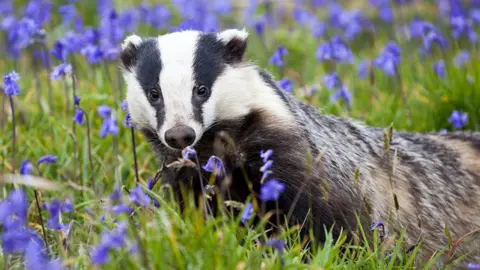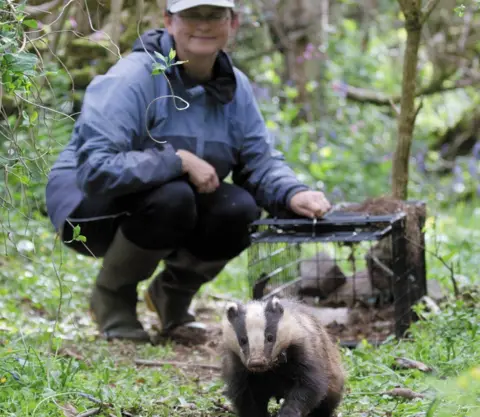Badger culls risk increased spread of TB to cattle, study finds
 Seth Jackson
Seth JacksonCulling badgers drives them to roam further afield, allowing them to disperse tuberculosis over a larger area, new research suggests.
The culls might thus increase the risk of TB spreading to cattle, the scientists behind the study warn.
The government commissioned its own review of the culls, but has yet to respond to the recommendations.
The review urged the government to explore alternative approaches to culling.
It was led by zoologist Sir Charles Godfray, from Oxford University.
The government said its own research indicated that the culls were working.
Co-author Rosie Woodroffe, from the Zoological Society of London (ZSL), said the results backed the scientific consensus that culling will - at best - slow the spread of TB only to a modest extent.
Additionally, it could potentially accelerate infection.
"There is an expectation from some farmers that the cull will be a silver bullet and it will make everything much better. But these results explain why those expectations are so misplaced," Prof Woodroffe told BBC News.
"Culling is a very imperfect way of controlling the spread of TB from badgers to cattle."
Dominic Dyer, chief executive of the Badger Trust, said the authorisation of culling licences in 11 new areas was taken before the government had responded to its own review of badger policy. This was "a national disgrace", he said.
Mr Dyer added: "Badger vaccination removes the risk of perturbation and brings farmers and wildlife protection groups together in a spirit of mutual respect, trust and confidence.
"The focus should then be moved to improving TB testing systems, bio security measures and cattle control movements, as recommended in the Sir Charles Godfray TB Policy Review."
A spokesperson for the Department for Environment, Food and Rural Affairs (Defra) said it would respond to Prof Godfray's review in the "near future".
Prof Woodroffe was among a group of researchers who explored the effectiveness of culling in extensive trials lasting nine years from 1998 to 2006. The Krebs Trial found that culling did control TB to some extent in the cull areas, but found that it temporarily increased cattle TB in surrounding zones.
The assumption was that although the culls reduced the number of infected badgers, the ones left were more effective in spreading infection because they moved around more. The new study, published in the Journal of Applied Ecology, confirms that assumption.
Co-author Cally Ham, from ZSL, tracked the movement of 67 badgers with GPS collars across 20 cattle farms in Cornwall, in areas with and without culling.
 ZSL
ZSLShe found the badgers in culling areas covered an area of land 61% larger than badgers in zones without culling. They also visited 45% more fields. The odds of a badger visiting the territories of other badgers each night increased 20-fold. The increased movement began as soon as culling began.
These observations are significant because badger to cattle transmission of TB is thought to be principally from bacteria left in fields by infected badgers. The increased movement caused by culling could, therefore, create a source of infection for several months, long after individual badgers have been culled.
"This potentially increases the risk of TB transmission both to cattle and to other badgers," said Ms Ham.
The culls were instigated in 2012 because of hardship to farmers and the growing cost of the disease to the UK economy, which currently stands at £500m over the past 10 years. This is projected to increase to £1bn in the next 10 years, according to the National Farmers Union (NFU).
The NFU's vice president, Stuart Roberts, said he believed culling was reducing the incidence of cattle TB.
"We are still awaiting the peer-reviewed report examining the effectiveness of the cull at reducing TB," he said.
But he added: "Previously published peer-reviewed research, and anecdotal evidence from farmers in these areas, indicates strongly that TB is being reduced as a result of controlling the wildlife which carry and spread the disease. We do not see similar convincing outcomes from vaccination."
A Defra spokesperson said the department's cattle TB control policy already takes into account a potential increase in badger movement by ensuring there is an intensive cull across an area.
"Research shows culls in higher risk areas have had a positive impact on [bovine TB] incidence in cattle, which is the key measurement by which the effectiveness TB prevention can be tested," they said.
"There is no single measure that will provide an easy answer to beating the disease and we are pursuing a range of interventions to eradicate it by 2038, including tighter cattle movement controls, regular testing and vaccinations."
Follow Pallab on Twitter
